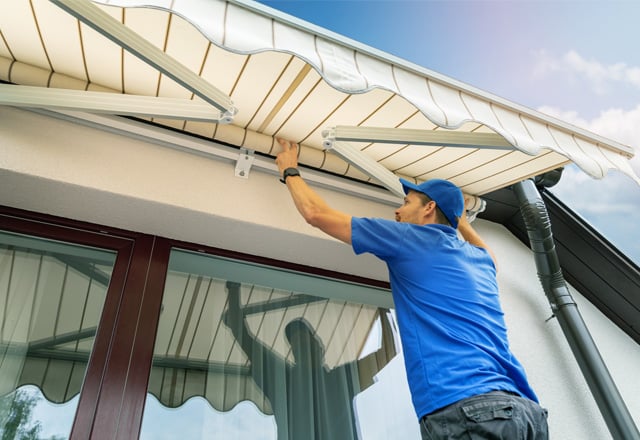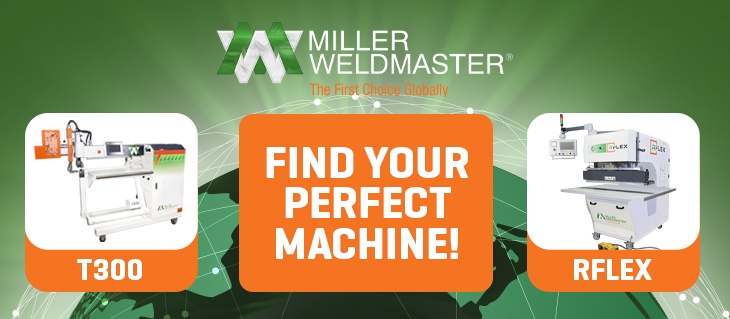In the awning industry, welding is used for multiple purposes such as connecting metal frames, affixing the fabric to the edge, or strengthening various components. Awning welds ensure that the finished product can withstand environmental stressors such as wind, rain, snow, and even the weight of occasional snowfall.
Awnings typically feature two main components - the frame and the fabric. The frame, generally made of metal, provides the structure for the awning, while the fabric offers a protective covering. While frames are typically welded together using traditional welding techniques, fabrics are often joined using processes like heat welding or RF (Radio Frequency) welding, which we'll cover later.
Types of Welding in Awning Fabrication
- RF Welding - RF (Radio Frequency) welding, also known as high-frequency welding, is widely used for joining pieces of awning fabric. During RF welding, an electromagnetic field is used to generate heat and cause the fabric to melt and fuse together. This technique creates a reliable and waterproof seal, ideal for awning applications
- Heat Welding - Heat welding, as the name implies, uses heat to join pieces of fabric together. This process is frequently used on thermoplastic materials, like PVC and some types of vinyl, which become pliable when heated. Once the fabric is cooled, the two pieces are effectively fused together.
- Hot Air: Hot Air Welding uses a precise stream of hot air that is directed between the 2 pieces of fabric as it moves through the machine
- Hot Wedge: Hot Wedge, similar to hot air, uses a metal wedge that is run along the fabric as it is pulled through the machine to create the bond.
- Sewing - While sewing is not technically welding, it is a common technique used for manufacturing awnings. By utilizing heavy-duty threads and specialized sewing techniques, manufacturers can create awnings that can stand the test of time.
The Importance of Quality Awning Welds
Quality awning welds are essential for several reasons. First and foremost, they provide the necessary structural integrity to the awning. High-quality welds ensure the awning can resist environmental pressures and wear and tear over time.
Secondly, quality welds play a crucial role in the visual appeal of an awning. Clean, well-made welds on the frame and fabric contribute to a professional and polished appearance. This is particularly important for businesses that use awnings as part of their branding or for homeowners who want their awnings to complement their property's aesthetic.
Finally, quality welds ensure the safety of the awning. Weak welds can result in the collapse of the awning, potentially causing damage or injury. Therefore, it's crucial that all welds are done correctly and inspected for quality and durability.
How do you weld the fabric of the awning?
Heat and RF welding involves the using of controlled heat or electromagnetic waves between 2 pieces of fabric and melding the adjoining surfaces of the material together.
The Hot Air and Hot Wedge process begins by overlapping the two pieces of material of your choosing. Using what we call guides, helps the operator to keep the material in position as it moves through the machine. Then, the heat, either air or wedge, is pushed between the material at the seam, effectively melting both surfaces. Immediately following this, a roller is used to press the melted surfaces together. It's crucial to maintain a consistent pressure, temperature and speed to ensure a uniform weld. The temperature and speed is controlled by the machine and will vary based on your material. The pressure is essential and is done using weld rollers. The rollers are essential because it pulls the material through the machine while also applying pressure to the material after the heat is applied to mold the material together.
On the other hand, RF welding, or dielectric sealing, utilizes electromagnetic energy to generate heat within the molecules of the materials. When the material is placed between two electrodes and exposed to high-frequency waves, the internal heat generated causes the material to melt and bond. This method is particularly effective for welding large areas and producing clean, consistent seams. Proper grounding and safety measures are paramount when using RF welding, as it deals with high-frequency electromagnetic fields.
Both techniques, when executed correctly, result in durable and waterproof seams ideal for awning applications.
Conclusion
Understanding awning welds and the techniques used can help you appreciate the craftsmanship that goes into each awning. As with any investment for your business, knowledge is key. Here at Miller Weldmaster, we will make sure you find out which is right for you and your business with complete ease and help you get started. Whether it be hot air, hot wedge, or RF; Miller Weldmaster has a solution for you!
If you are interested in learning more about our Awning Solutions, please contact our team of experts!


